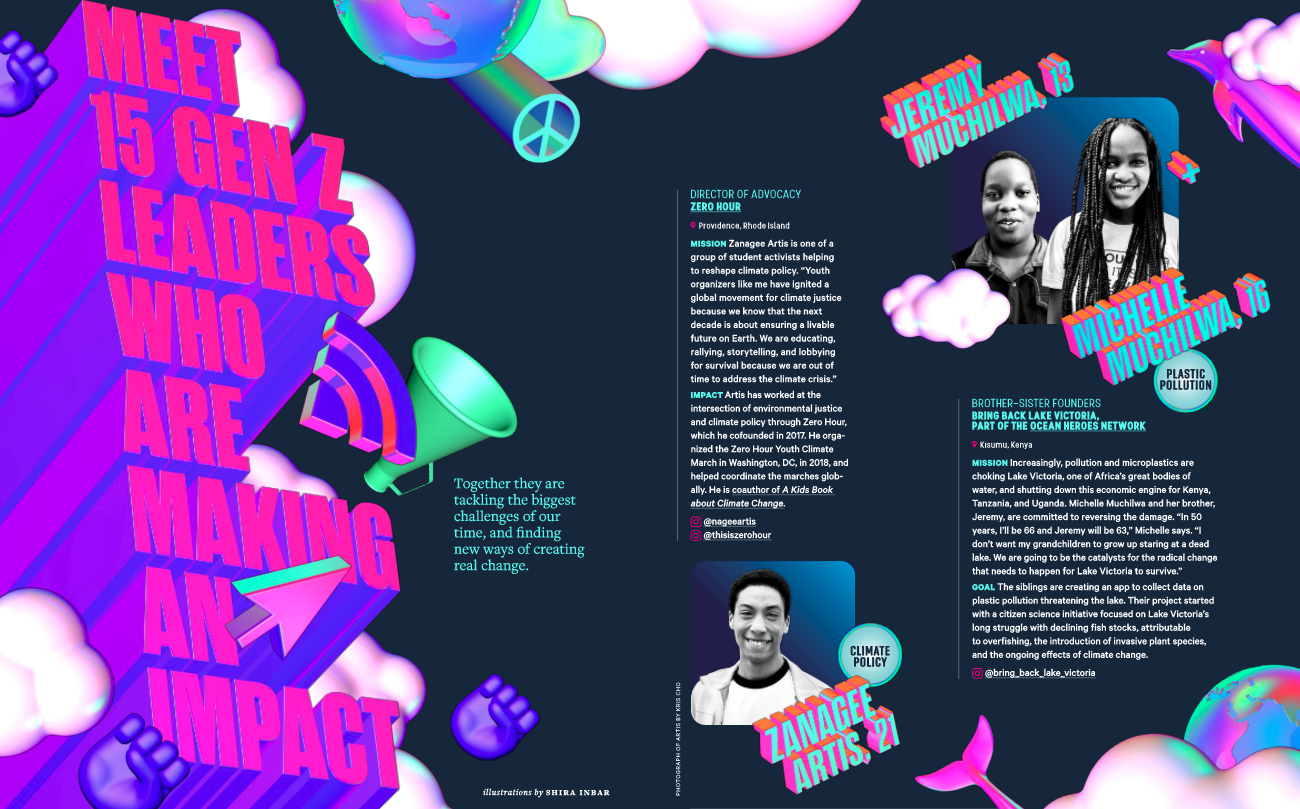Storytelling
Getting Gen Z: Inside HP’s Colorful & Creative Innovation Magazine
In March 2020, Sunshine Flint, executive editor of HP’s brand publications Innovation magazine and The Garage, hired someone to help her team produce more content. The new 23-year-old employee was fresh to the industry and bubbling with enthusiasm. But before she ever had the opportunity to come into the office, she had to switch to a fully remote work model due to COVID-19 office closures.
“That sparked an idea,” Flint said. “How is Gen Z faring as the first cohort to start their career in a hybrid or remote workforce?”
That story and others inspired by Gen Z soon ballooned into a 70-page issue of Innovation dedicated to “Generation Rising.” HP’s magazine, released for summer 2021 in both digital and print format, also coincided with the launch of a new film series on Gen Z—”Generation Impact“—the brand produced.
We sat down with Flint to chat about Innovation, the impetus behind HP’s Gen Z-focused marketing efforts, and the creative process that goes into bringing these ambitious content projects to life.
Why Gen Z?
As the first truly digitally native generation, Gen Z is attractive to technology companies—both as employees and customers. Experts predict that by 2023, Gen Z will be the biggest generational cohort in the economy. Paying attention to this group’s preferences and media patterns, including how they consume content, is no longer optional.
In response, brands like HP are getting creative with the ways in which they talk to this up-and-coming demographic. Publications like Innovation and The Garage fulfill dual purposes: They inform internal employees about company updates, and they entertain customers loyal to the brand.
Issue releases also tend to coincide with the HP’s larger objectives and tentpole calendar events. Last fall, for example, the company created an issue of Innovation focused on environmental initiatives in order to align with its annual sustainability report.
With “Generation Rising,” HP wanted to showcase how young people are using technology for social good while teasing their “Generation Impact” film series. The first installment of that series, a short film called The Coder, which features a young woman’s efforts to start a coding school for Black students, debuted in June 2021. The digital magazine came out the same month, and the print version was released in July.
The omnichannel tactic is smart, considering Gen Z’s tendency to prioritize video and other visual content over more traditional forms of marketing. The Innovation issue takes these preferences into account too. Beyond longform articles, the magazine features lively, colorful illustrations; infographics; and the digital version even has an animated cover.
Bringing Innovation to life
Bringing this latest issue of Innovation to life took about four months. The magazine comes out three times a year, so there’s a good deal of lead time before each release. It’s hosted on the interactive publishing platform Joomag, and readers can sign up for a digital subscription online.
When working on a new issue, Flint’s team brainstorms story ideas, writes the pieces, and designs copy, illustrations, animations, and more. Since the vast majority of the Innovation team comes from a background in publishing—mostly magazines—they’re well-versed in the mechanics of such a multifaceted project.
When necessary, HP also taps freelance talent. “We are a small and mighty team in-house, but you need lots of talent to make a magazine,” Flint said. “We use freelance writers, photographers, illustrators, editors, copy editors, art directors, and producers.”
Of course, the pandemic threw a new wrench in the process—Flint and the rest of HP’s brand journalism team had to adapt to working 100% remotely. Though it was an adjustment, Flint said that it hasn’t hindered their creativity. The team uses platforms like Slack, Zoom, Google Docs, Dropbox, Adobe InDesign, and InCopy to toss around ideas, read proofs, and more.
“I think there is always going to be a place for magazines… it just might not be on the newsstand.”
“Regarding remote collaboration… It’s happening. It’s working. We’re doing it,” Flint said. “Are there days when it would be easier if we were all together under one roof? Sure. But overall, I think we’re doing great work.”
Gen Z was a “rich topic” when HP sat down to brainstorm story concepts. The issue includes stories ranging from Gen Z in the workplace—a piece on internships and another on the “new commute” for remote workers—to short profiles of 15 young people making a social impact via various tech platforms. Each subject has a connection to the brand: some through direct partnerships, and others through non-governmental organizations that work with HP.

“Many of them are based on consumer insights that have been floating around,” Flint said. “For the Gen Z issue, nobody presented us with hard-and-fast facts or data points. We just understand that this is an upcoming priority.”
But, Flint noted, HP’s ongoing investment into digital content, distribution, and social promotion will soon give them more information to work with. “We’re hoping to start getting some of that data to be able to see what performs well, where people are coming from, where stories land, etc.,” she said.
Reaching Gen Z and the future of magazines
HP isn’t the only technology company focusing its content marketing on Gen Z.
Since data suggests that this generation is particularly invested in sustainability and social impact, brands like Samsung and Dell are increasingly experimenting with inspirational storytelling, charitable initiatives, and inclusive messaging. To align with Gen Z’s content preferences, many legacy brands are turning to popular formats like shortform videos on TikTok and Instagram Reels, as well as smaller and more intimate “digital campfires” on emerging platforms like Fortnite, Discord, and Twitch.
Flint believes old-school magazines still have significant value—even for this digitally native generation. (Innovation is released both online and via a small print run of about 700 copies. Flint hopes to expand that number as more people return to the office, where Innovation is typically distributed.)
“I think magazines still resonate with younger generations because there’s just more richness and depth to this type of content,” she said. “It’s packaged in a way that’s very different from the [newsfeed].”
There’s something permanent and trustworthy about a tangible magazine—the physicality of it makes it less ephemeral than the snippets younger generations have grown accustomed to scrolling by on social media. Some reports have even found that consumers trust magazines more than other sources of news, including television and radio.
In the context of content marketing, HP hopes that the familiar format—including the authoritative executive letter in the front, the in-depth reporting and fact-checking, and the engaging mix of imagery and copy—is an effective way to reach both internal employees and potential customers affiliated with Gen Z.
“There’s power to the printed form. There’s power to a front of the book that has your executives’ voices in it,” she said. “I think there is always going to be a place for magazines… it just might not be on the newsstand.”
Image by HPGet better at your job right now.
Read our monthly newsletter to master content marketing. It’s made for marketers, creators, and everyone in between.




